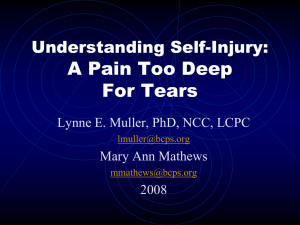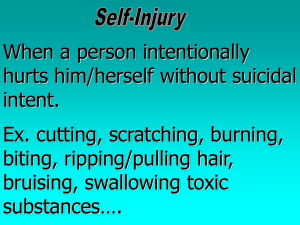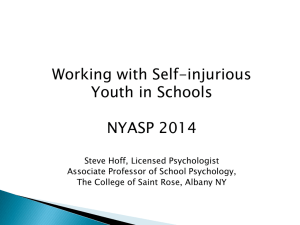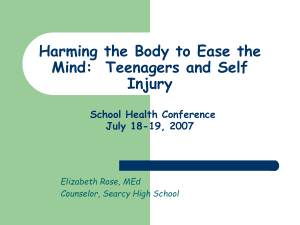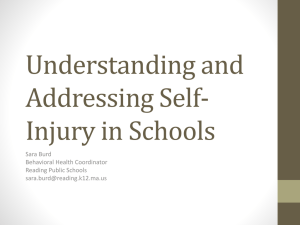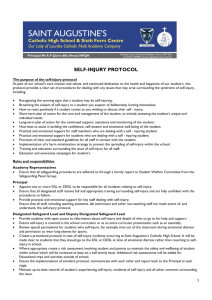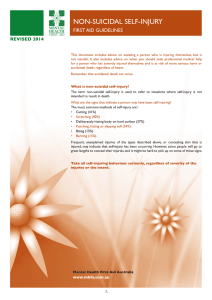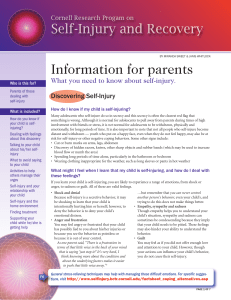supporting material
advertisement
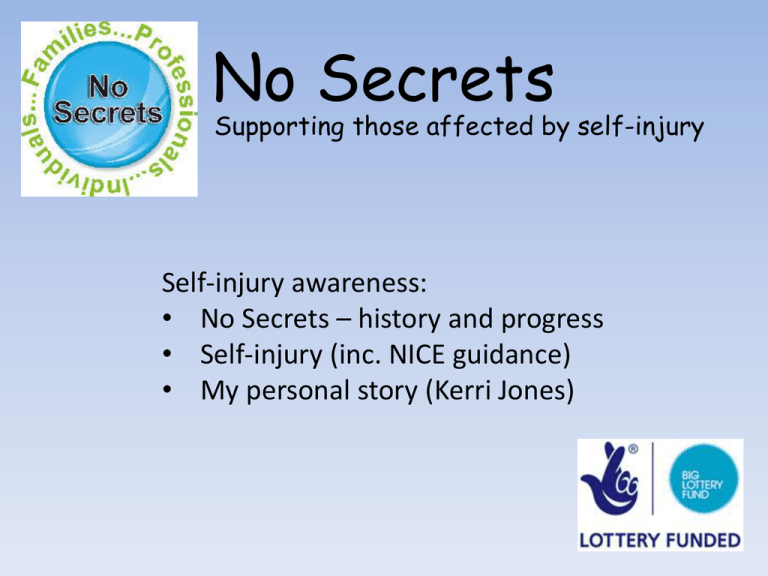
No Secrets Supporting those affected by self-injury Self-injury awareness: • No Secrets – history and progress • Self-injury (inc. NICE guidance) • My personal story (Kerri Jones) WARM UP Exercise 1 Why No Secrets started... • • • • • • Co-founded Oct 2007 – 2 volunteers Lack of support ‘Alone’ – me and family Lack of understanding Nobody spoke about it “No Secrets” – how we want it Our Mission • To provide a safe and supportive environment for anybody affected by self-injury • To raise awareness of self-injury • To tackle stigma associated with self-injury We aim to achieve the above by providing peer support, providing awareness-level training, running awareness campaigns, communicating with as many as possible and working closely with local health services. Since October 2007... • • • • • Group 1 St Helens continuing to run Group 2 Wigan started early 2011 Group 3 Halton launched May 2011 Group 4 Family/friend support – 20th July @ PB Continual awareness level training to over 200 people • Local press, Saints (RLFC), ‘Pick Me Up’, BBC News • Now have 10 volunteers • Successful activities/fundraisers Sponsored Abseil – St Helens Sponsored mountain climb Donut men – Wigan group 2011 No Secrets in one sentence... • “A feeling of belonging and that I’m not alone” • “Means I can make a difference to other people’s lives” • “Support and guidance, and friends when you need it most” • “People understand self-harm, and me” • “No Secrets is a fantastic place to open up and meet new friends” • “A safe place just to ‘be’” • “I belong!” • “People committed to improving lives” No Secrets in one word... • • • • • • • • • • “Friendly” “Helpful” “Reliable” “Super” “Hope” From Wigan & St Helens group members in, April 2011 “Happy” “Inspirational” “Accepted” “Friendship” “Peace” Self-injury Definition adopted by NICE: “intentional self-poisoning or injury, irrespective of the apparent purpose of the act”. Not always connected to suicide. Majority preventing suicide. 2 categories: Self-injury and self-poisoning. Self-injury/self-poisoning • SI - Cutting, swallowing objects, insertion of foreign objects into body, burning, stabbing. • SP – overdosing with medicines, swallowing poisonous substance. • Self-injury more common than self-poisoning, this is not reflected in statistics. • People who self-poison are more likely to seek professional help. NICE: Clinical need for guidance • 150,000 presentations to A&E each year • UK rates are amongst highest in Europe • Half of the 4000 people who die each year by suicide will have self harmed at some point • Self-poisoning most commonly seen in ED’s • Cutting most common form of SI • 100x more likely than general population to die by suicide, whether intentional or accidental Information from Clinical guideline 16 NICE: Key priorities for implementation • • • • • • • Respect, understanding and choice Staff training Activated charcoal Triage Treatment Assessment of needs and risk Psychological, psychosocial and pharmacological interventions Information from Clinical guideline 16 Risk factors & life events • • • • • • • • Single Divorced Live alone Single parent Severe lack social support Disadvantaged background Victimisation (domestic abuse, sexual abuse etc) Alcohol/drug use Information from Clinical guideline 16 Psychological characteristics • • • • Certain characteristics more common in SH: Impulsivity Hopelessness Poor problem solving • Nearly ½ those presenting to ED’s with SI meet criteria for having a PD (though this can bring it’s own problems) How many self-inflicted injuries did Warrington A&E treat within the space of 9 months (1st April- 31st Dec) in 2010 What percentage of that 802 were male? What was the average age of all 802 people who presented to Warrington A&E? WHY DO WE SELF HARM? • • • • • • • • • • • • Relieves tension Punishment Calming/self soothing Focus shifts from emotional to physical Control Adrenaline rush Numbness/detached - “It makes me feel alive” Anger and self-hatred Depression “jeckle and hyde effect” Very upset Problems can seem smaller afterwards Anxiety IF ONLY YOU COULD GET IT! • Self harm makes me feel something when I feel numb • I don’t do it for attention • I’m hurting myself, nobody else • It’s mostly easier not to tell anyone I’ve done it • A bigger wound doesn’t mean worse feelings • We can have accidents too It helped when… • The professionals working with me weren’t scared of talking about self harm. • My support worker expressed they wanted to understand as much as possible • Somebody accepted that self-injury is my way of coping for the time being • I was told to be ‘safe’ rather than told not to do it • People truly believed I didn’t want to keep hurting myself, even though it didn’t come across that way • I was offered support after telling somebody about my self harm, rather than being told I was seeking attention and being manipulative. It really didn’t help me when: • People said I was being stupid or I should have known better • Staff got annoyed with me after I’d harmed, for not talking about it before I did it • A&E staff refused me pain relief • Someone took all my sharps away (where no suicidal intent present) • I heard people laughing at me • Staff said they were disappointed in me • I was reminded of those who I love and told how much I was letting them down • People made a big deal of it when they didn’t need to In summary DO DON’T Talk about SH and ask if you are unsure Ridicule/put me down Understand as much as possible and reflect on your actions Blurt out responses Accept Treat differently from everyone else Be Safe Remove my only coping mechanism Believe & encourage Laugh/make fun of Non-judgmental support Focus on negatives of SH Generally, focusing solely on negatives to self-injury will make person feel worse. Try to explore a variety of potential positives and negatives (Sharon) My story • Abused in early childhood • Uni, deaths (april – Aug), cutting and suicide attempts 2005-2006 - SIPU • 2007 Started voluntary work and co-founded No Secrets with mum • Extent of abuse accidentally revealed to family • Reported abuse to police • Self-injury – as long as remember. My release from overwhelming feelings of sadness, selfhatred and anger. What I’ve learned since initial breakdown • • • • • • • Honesty is vital Acceptance important Actively work on tackling problems Help others with similar issues I’m not alone I’ve achieved more than I thought capable Anchors – family, friends, pets Open Q&A • This is your chance to ask any questions around self-injury and/or mental health problems • We will always be honest and do not worry that any questions will act as a trigger • We want you to be honest • Bring up anything you may want to discuss within the group • Your questions help us to see how it is from your perspectives Feedback and check out • Share with the group what you have learned from this session • It’s important that we remember that anybody can be affected by self-injury. If you have been affected by this session try to speak to somebody before you leave • Check-out... What are you going to do this evening? Evaluation • We would be grateful if you could complete the evaluation form for us to feedback your own thoughts on how this session went • This will help us to improve and continue the work we are doing Thanks! More details can be found on our website: http://nosecrets.moonfruit.com For more information on the WIGAN group, contact Kerri on 07846 889 300 or email kerri86@gmail.com For more information on the ST HELENS or HALTON groups contact Tina on 07863 736 647 or email tina.sthelens@gmail.com Thank you for your support!

